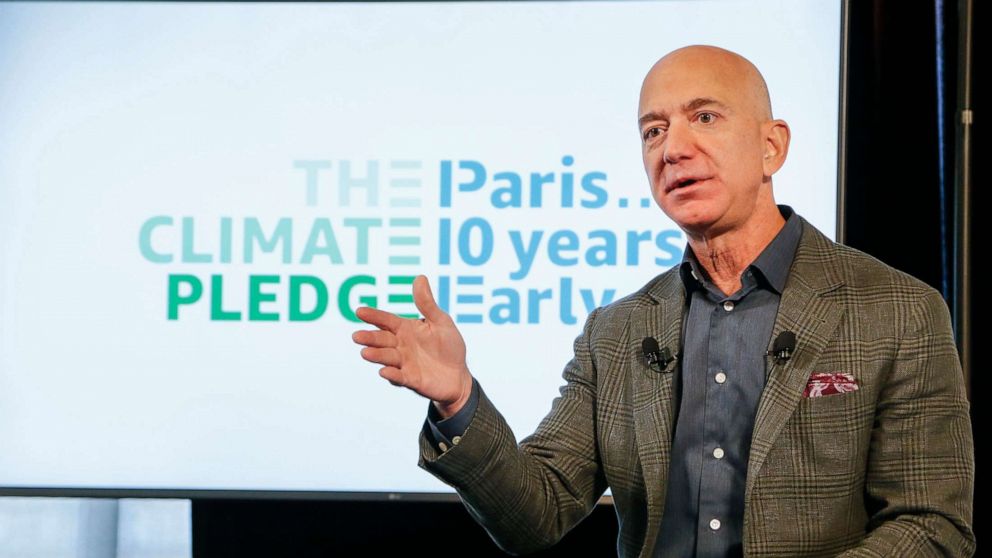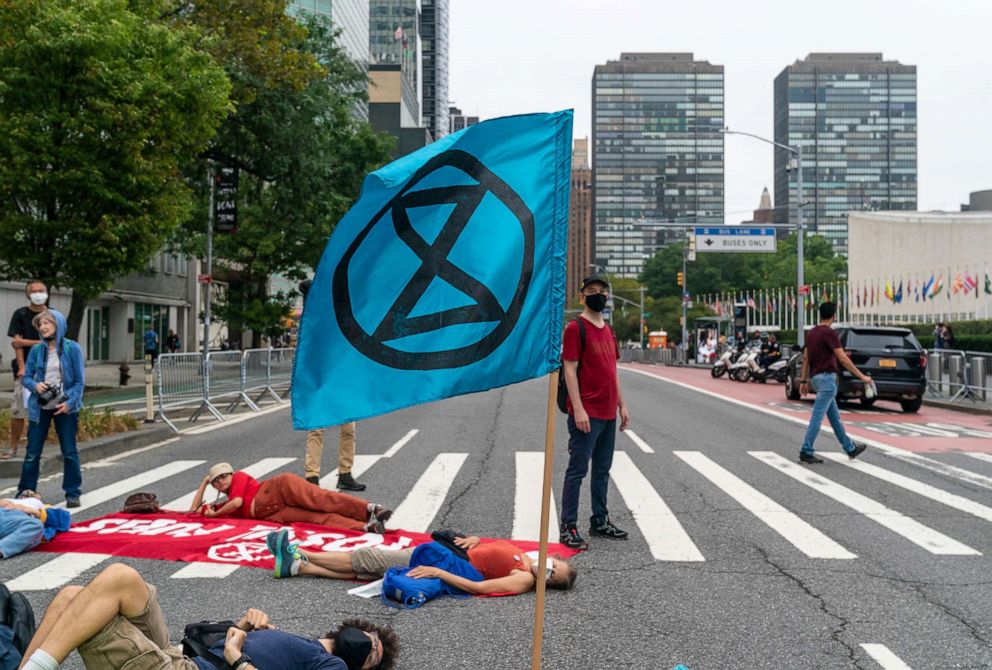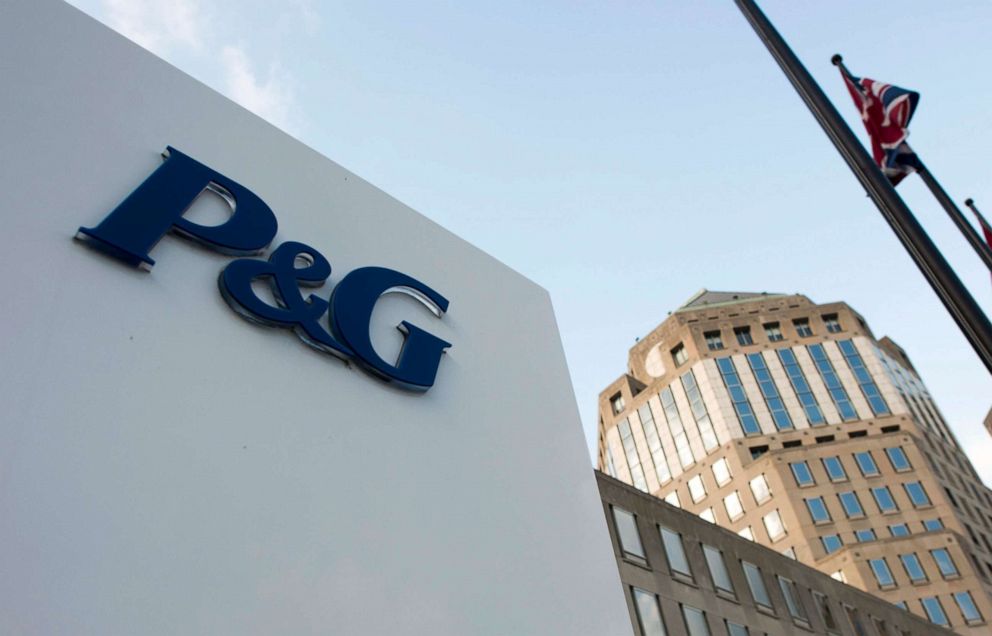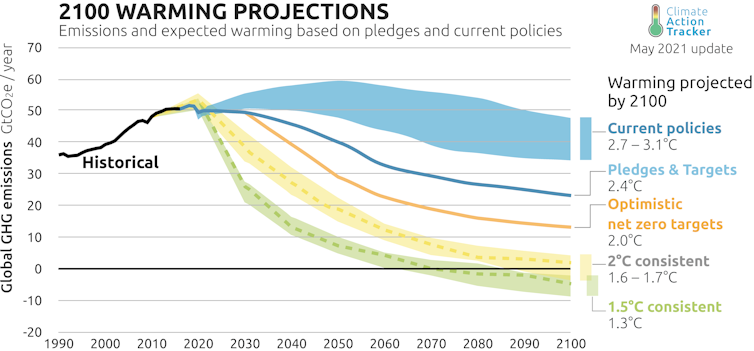More companies pledge ‘net-zero’ emissions to fight climate change, but what does that really mean?

The world’s pledges so far aren’t enough to stop climate change, U.N. data show. Metamorworks via Getty Images
You’ll probably hear the term “net-zero emissions” a lot over the coming weeks as government leaders and CEOs, under pressure, talk about how they’ll reduce their countries’ or businesses’ impact on climate change. Amazon, for example, just announced that more than 200 companies have now joined its Climate Pledge, committing to reach net-zero emissions by 2040.
But what does net-zero emissions actually mean?
“Zero emissions” – without the “net” caveat – means emitting no greenhouse gases.
“Net-zero emissions” has more wiggle room. It’s like balancing a checkbook. The country or company cuts most of its emissions through efficiency and clean energy, then offsets the rest by removing carbon dioxide from the atmosphere or eliminating emissions elsewhere.
Written by academics, edited by journalists, backed by evidence.Get newsletter
For example, trees absorb carbon dioxide from the air, so they’re often considered “negative emissions.” The tiny Himalayan kingdom of Bhutan can claim net-zero emissions because almost all of its electricity comes from hydropower, and its forests sequester about three times more carbon than its vehicles, factories and other human activities emit.
Companies have another way to claim net-zero emissions – they can take advantage of carbon reductions elsewhere by buying carbon credits. For example, a U.S. company might pay to protect forests in South America and then subtract those trees’ negative emissions from its own emissions to say that its operations are “net-zero.” Other carbon credits support sustainable development projects, such as installing wind or solar power in poorer countries.
But counting on carbon credits also draws criticism, because it allows those companies to keep generating greenhouse gases. Other concerns are that some projects would happen anyway, the emissions reductions might not be permanent or even verifiable, or they might get double-counted by more than one entity. Some projects, like tree planting, can take years to pay off in emissions reductions while the companies buying forest offsets continue emitting greenhouse gases.
Global coverage of national net zero emissions pledges
By early 2021, countries accounting for more than 70% of global carbon dioxide emissions had pledged to reach net zero emissions by mid-century. The chart shows how much of the global GDP, population and carbon dioxide emissions are covered by those pledges.
Why does net-zero emissions matter?
Greenhouse gases trap heat near Earth’s surface. When their concentrations get too high, they fuel global warming.
In 2015, countries around the world agreed to limit global warming to well under 2 degrees Celsius (3.6 F) compared with preindustrial times, with a goal of 1.5 C (2.7 F). To keep warming under 1.5 C with the least disruption, the United Nations says the world needs to be on a path to reach net-zero emissions by about 2050. To put those temperatures into perspective, global warming today is just over 1 C (1.8 F) above preindustrial levels, and rising seas and extreme weather are already a problem.
Several countries, including the United States, have pledged to meet the goal of net-zero emissions by 2050. But when the U.N. analyzed each country’s commitments under the Paris Agreement in mid-September, it found they still fall short by so much that even if every pledge is met, temperatures will rise about 2.7 C (4.86 F) this century.
To see how a company might get to net-zero emissions, let’s imagine a hypothetical company, ChipCo, that makes, packages and distributes potato chips. ChipCo purchases electricity from a local utility to run machinery at its factory. It also has boilers to generate steam to heat the building and for some production processes. And it uses delivery trucks to transport its products to customers. Each step generates greenhouse gas emissions.
To achieve net-zero emissions, ChipCo’s first step is to ramp up energy efficiency. Improvements in insulation and equipment can reduce the amount of energy needed or wasted. A simple example is switching out incandescent light bulbs that use 60 watts of energy with LED bulbs that give off the same brightness, yet consume only 8 watts.
The second step is to switch from fossil fuels – the leading source of human-caused greenhouse gas emissions – to renewable energy, such as solar or wind power, that doesn’t produce greenhouse gas emissions. Once the company’s electricity is renewable, using electric delivery vehicles further cuts emissions.
Homes and office buildings can also be built to net-zero, or carbon-neutral, standards. In that case, the focus is on making them extremely energy-efficient and relying on heating and electricity from clean energy sources.
The falling costs of renewable energy
A comparison of the average levelized cost of utility-scale power generation, without subsidies, shows how new solar and onshore wind became less expensive than coal generation. Costs are in U.S. dollars per megawatt-hour. GO TO More companies pledge 'net-zero' emissions to fight climate change, but what does that really mean? (theconversation.com)
ChipCo’s third step is finding negative emissions. It might be too expensive or not yet technologically possible for it to replace its steam boiler with a carbon-neutral product. Instead, ChipCo might purchase carbon credits that would remove the same amount of carbon from the atmosphere that would be generated by the boiler.
Companies are increasingly under pressure from governments, activists and their customers, as well as some powerful investors, to cut their emissions.
To tell if a company is taking its responsibilities seriously, look for its action plan and performance so far. A company that announces a net-zero target of 2030 can’t wait until 2029 to take action. There needs to be a consistent trajectory of improvements in energy efficiency and clean energy, not just promises and carbon offsets.
The announcement comes in the wake of a dire warning from a UN climate panel.
ByCatherine Thorbecke
20 September 2021,

Paul Morigi/Getty Images
Amazon CEO Jeff Bezos announces the co-founding of The Climate Pledge at the National Press.
The Climate Pledge now totals 201 companies, who employ more than 7 million people worldwide.
Nearly 90 new companies -- including multinational corporate giant Procter & Gamble, tech behemoth HP and cloud-computing titan Salesforce -- have signed onto the Climate Pledge, an Amazon-backed initiative that asks firms to commit to achieving net-zero carbon emissions by 2040.
Organizers of the Climate Pledge announced Monday a total of 86 new signatories, bringing the total number of companies involved to 201. The new commitments come as the United Nations General Assembly kicks off in New York City, with climate change talks expected to take center stage among the high-profile meeting of world leaders.
MORE: 'Unequivocal' that human influence has warmed the planet, UN climate panel finds
It also comes in the wake of a recent report from a U.N. panel -- that U.N. Secretary-General António Guterres called a "code red for humanity" -- warning of dire environmental consequences if immediate action is not taken to cut back greenhouse gas emissions

LightRocket via Getty Images
Members of Extinction Rebellion stage protest against companies supporting oil, gas and
ASOS, Nespresso and Selfridges are among some of the other household names who joined the pledge Monday. Altogether, pledge signatories employ more than 7 million employees across 26 industries in 21 countries.
"I believe that now, more than ever, companies like Amazon have an obligation to lead the fight for our planet," Andy Jassy, Amazon's CEO, said in a statement Monday.
"But, solving this challenge cannot be accomplished by one company; it requires all of us to act together, and it’s one of the reasons we’re so excited to announce that more than 200 businesses have joined us in signing The Climate Pledge -- a commitment to reach the goals of the Paris Agreement 10 years early," Jassy added.
David S. Taylor, Procter & Gamble's CEO and president, echoed Jassy's sentiments in a separate statement, saying that addressing climate change effectively, "requires collaboration across industries and credible science-based actions."
"P&G has made significant progress over the past decade and we know we must do more," Taylor added. "The task ahead is urgent, difficult, and much bigger than any single company can solve alone. P&G is proud to join The Climate Pledge as we work together to preserve our shared home for generations to come."

Bloomberg via Getty Images, FILE
Proctor & Gamble Co. headquarters stands in downtown Cincinnati, Ohio, Aug. 19, 2014.
If all of the firms followed through on their promise, they would collectively mitigate some 1.98 billion metric tons of carbon emissions by 2040, according to an estimate from initiative organizers, or 5.4% of the current global annual emissions.
The firms have committed to measuring and reporting their greenhouse gas emissions on a regular basis, implement decarbonization strategies in line with the Paris Agreement's goalposts, and neutralize any remaining emissions with additional and quantifiable offsets.
MORE: Citing human rights risks, UN calls for ban on certain AI tech until safeguards are set up
A report issued last month by a U.N. panel that warned that the impacts of human-caused climate change are severe and widespread -- and that while there is still a chance to limit that warming, some impacts will continue to be felt for centuries.
The report from the U.N.'s Intergovernmental Panel on Climate Change called for "immediate, rapid and large-scale reductions in greenhouse gas emissions" in order to limit future warming to 2 degrees Celsius over pre-industrial levels, as is the goal of the Paris Agreement by 2050. The report also warned that unless greenhouse gas emissions are drastically reduced, the world will exceed 1.5 degrees of warming in the next 20 years.
When calling the report a "code red," U.N. Secretary-General António Guterres added that, "The alarm bells are deafening, and the evidence is irrefutable: greenhouse‑gas emissions from fossil-fuel burning and deforestation are choking our planet and putting billions of people at immediate risk."
..
Jeff Bezos, Amazon's then-CEO, announced the Climate Pledge and the company's plan to commit to net-zero carbon emissions by 2040 -- a decade ahead of the international Paris Agreement -- in 2019. At the time, Bezos said that if Amazon "can meet the Paris Agreement 10 years early, then any company can."
MORE: Young people experiencing 'widespread' psychological distress over government handling of looming climate crisis, researchers say
Christiana Figueres, the U.N.’s former climate chief and now founding partner of Global Optimism -- the advocacy group spearheading the Climate Pledge with Amazon -- said in a statement Monday that the IPCC report is the starkest warning yet that "the window of time to act decisively is narrowing."
"This wake-up call from science must be faced with courage and conviction," she added. "In this light, it’s encouraging that 86 more companies -- some of the largest household names in the world -- are now joining The Climate Pledge, committing to accelerate their actions to tackle climate change in a timely fashion, and playing their part in building a low-carbon economy."
The private sector has faced immense pressure from consumers and even shareholders in recent years to address climate change. "Industry" accounted for a whopping 23% of greenhouse gas emissions in 2019, according to the U.S. Environmental Protection Agency, behind only transportation (29%) and electricity production (25%) -- data some advocates say highlights the need for large-scale industry changes vs. putting the onus to tackle climate change solely on individuals.
HP, Procter & Gamble join companies pledge to cut emissions
Mon., September 20, 2021,

BERLIN (AP) — Computer-maker HP, consumer goods business Procter & Gamble and coffee capsule company Nespresso have joined a corporate pledge to sharply cut their greenhouse gas emissions over nearly two decades.
The Climate Pledge, a grouping of companies and organizations spearheaded by Amazon, said Monday that it has signed up 86 new members for its voluntary measures. In total, the group now has 201 members with global annual revenues of more than $1.8 trillion, it said.
Other new members include telecoms company BT, truck-maker Scania and the Selfridges department store chain.
Together, the companies aim to cut almost 2 billion metric tons of carbon dioxide by 2040 — more than 5% of the current global total.
While the group's members are encouraged to eliminate as many emissions as possible, those that can't be avoided need to be completely offset in the next two decades. That means paying for measures to ensure as many emissions are absorbed by then as the companies continue to emit.
Scientists say the world needs to achieve ‘net zero’ emissions by 2050 if it wants to meet the Paris climate accord's goal of keeping temperatures from rising more than 1.5 degrees Celsius (2.7 degrees Fahrenheit) by the end of the century compared to pre-industrial times.
Kat Kramer, head of climate policy at the anti-poverty campaign group Christian Aid, welcomed the decision by big players in the private sector to aim for net zero emissions.
But she urged the focus to be on cutting as many emissions as possible in the coming decade, rather than focus on unproven technology to remove the carbon once it's in the atmosphere.

No comments:
Post a Comment